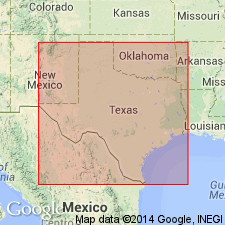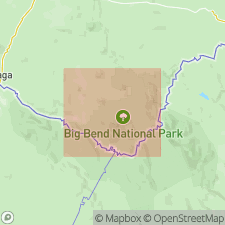
- Usage in publication:
-
- Hannold Hill Formation
- Modifications:
-
- Areal extent
- AAPG geologic province:
-
- Permian basin
Summary:
Pg. 12-33, pls., figs., tables, road logs. Hannold Hill Formation, uppermost formation of Tornillo Group. Predominantly clay but contains conglomerate and channel sandstone deposits that are fossiliferous in places. Thickness about 835 feet. Overlies Black Peaks Formation (new); underlies Canoe Formation in Big Bend Park Group (both new). Age is early Eocene.
Source: US geologic names lexicon (USGS Bull. 1350, p. 318).

- Usage in publication:
-
- Hannold Hill Formation
- Modifications:
-
- Principal reference
- Dominant lithology:
-
- Clay
- Sandstone
- AAPG geologic province:
-
- Permian basin
Summary:
Pg. 102-107, pIs. Hannold Hill Formation of Tornillo Group. Formal proposal of name. Formation is mostly clay and contains less coarse clastic material than the Black Peaks Formation. Sandstone and channel conglomerates occur, and the vertebrate remains of the formation are from them. Most clay is gray and maroon. Hannold Hill is only Tertiary sequence containing lignite. Contains Exhibit Sandstone Member (new) 320 feet above base. Thickness 833 feet at type section. Underlies Canoe Formation of Big Bend Park Group. Age is early Eocene based on fossils (Wasatchian vertebrates).
Type section: about 0.75 mi northeast of the abandoned rock crusher site on southern Tornillo Flat, Big Bend National Park, Brewster Co., southwestern TX. Named from Hannold Hill on the Big Bend Park road in south-central Tornillo Flat.
Source: US geologic names lexicon (USGS Bull. 1350, p. 318).
For more information, please contact Nancy Stamm, Geologic Names Committee Secretary.
Asterisk (*) indicates published by U.S. Geological Survey authors.
"No current usage" (†) implies that a name has been abandoned or has fallen into disuse. Former usage and, if known, replacement name given in parentheses ( ).
Slash (/) indicates name conflicts with nomenclatural guidelines (CSN, 1933; ACSN, 1961, 1970; NACSN, 1983, 2005, 2021). May be explained within brackets ([ ]).

